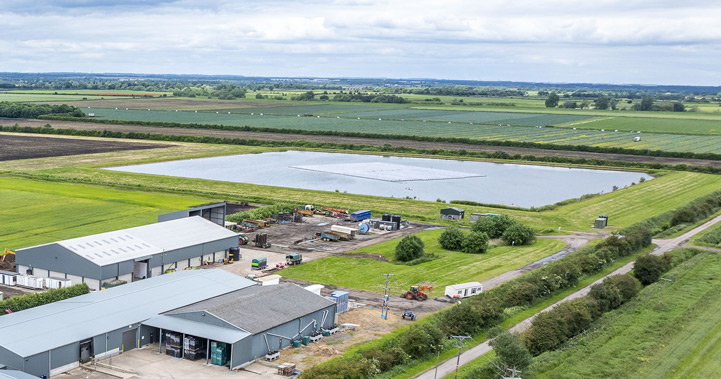Stacking a sustainable water supply with renewable energy for food production
- 40% grant received to fund 160,000m3 reservoir
- 12km pipeline replaced a diesel pump system
- 400kW array of floating solar panels stacked onto the reservoir

Pollybell Farm
James Brown owns and manages Pollybell Farm, a mixed organic farming business in north Lincolnshire. The core of the business is vegetable production, predominantly brassicas, as well as leeks, carrots and potatoes, which are all grown and packed on the farm. Grass clover leys are grazed with dairy cows and sheep, while the arable cropping consists of wheat, barley and beans, which are all used for animal feed.
Water is an essential ingredient for Pollybell Farm. Without it, the vegetable production enterprise would neither be possible nor sustainable
James Brown, Pollybell Farm
Water is an essential ingredient here. Without it, the vegetable production enterprise would neither be possible nor sustainable. The farm has already seen how climate change impacts the availability of water in its catchment where the EA has closed the catchment to new abstraction licences. The business historically had a number of summer abstraction licences, allowing it to abstract from surface waters (rivers) in the summer months only. The period of drier summers and wetter winters has meant the farm had to look more closely at the water resilience of the business. In 2012, James realised that a two-week buffer supply was needed to protect them in case their abstraction rights were stopped for any reason. This led him to consider the construction of a reservoir, which would allow water to be abstracted in the winter (via licence) and stored in the reservoir for use the following spring, protecting the rivers in the summer. As a result, the farm sought a government grant of 40% to fund a 160,000m3 reservoir and a new 12km pipeline, which now moves the water to where it is needed.
Building the reservoir meant that land had to be taken out of food production and in 2015 James decided to 'stack' a 400kW array of floating solar panels onto the reservoir. The benefits include:
- Reduced erosion of reservoir banks as the solar panels break up the wave action
- Solar energy now powers the irrigation system, which has reduced the carbon footprint
- The solar energy created is also used in the vegetable packhouse and cold stores.
James’ first three steps to achieving water resilience are:
- Obtain abstraction licences: Water abstraction remains the biggest challenge to the farm. As a whole, its catchment is over abstracted and achieving new licences is problematic and time-consuming.
- Seek planning permission: Obtaining permission for alterations to water systems, such as a reservoir, can take time, and working with the local authority can add complexity to a project.
- Apply for grant funding: In order to apply, steps 1 and 2 have to be in place.
Additional water security
The business also has a borehole abstraction licence (45,000m3), which provides water for washing the vegetables. This water is then recycled through a reed bed system and returned to the reservoir. Additionally, rainwater (green water) is harvested from the roofs of the cold store and packhouse and this also goes back into the reservoir. Through these measures, James is able to look at water on the farm through a circular economy lens. Keen to further develop water resilience for the business, he has the following future plans:
- The construction of an additional reservoir.
- Expansion of the new pipeline to support neighbouring farms, where, if also irrigated, Pollybell could rent the land for further production and support food security.
- A cooperative of farms, run with a central reservoir that provides water to other farmers for vegetable production.
- Consultation with the EA regarding peak flow abstraction licences.
Read the articles within Water: building resilience below.
.jpg)




